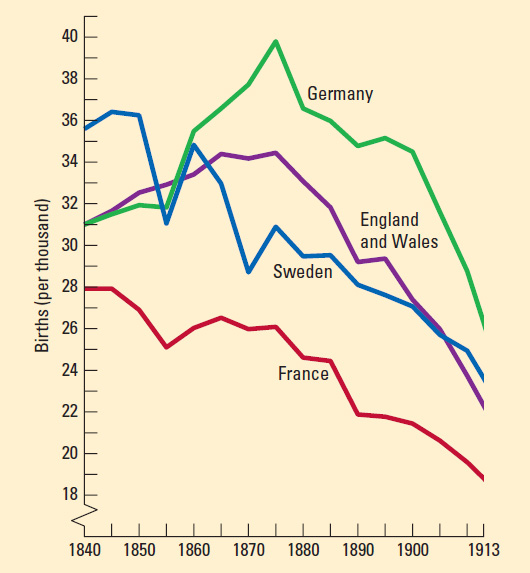A History of Western Society: Printed Page 739
A History of Western Society, Value Edition: Printed Page 744
Child Rearing
Another striking sign of deepening emotional ties within the family was a growing emphasis on the love and concern that mothers gave their infants. Early emotional bonding and a willingness to make real sacrifices for the welfare of the infant became increasingly important among the comfortable classes by the end of the eighteenth century, though the ordinary mother of modest means adopted new attitudes only as the nineteenth century progressed. The baby became more important, and women became better mothers.
The surge of maternal feeling was shaped by and reflected in a wave of specialized books on child rearing and infant hygiene, such as French family reformer Gustav Droz’s phenomenally successful book Papa, Mama, and Baby, which went through 121 editions between 1866 and 1884. Droz urged fathers to become affectionate toward their children and pitied those “who do not know how to roll around on the carpet, play at being a horse and a great wolf, and undress their baby.”10 Following expert advice, mothers increasingly breast-fed their infants, rather than paying wet nurses to do so. Breast-feeding involved sacrifice — a temporary loss of freedom, if nothing else. Yet when there was no good alternative to mother’s milk, it saved lives. Another sign, from France, of increased parental affection is that fewer illegitimate babies were abandoned as foundlings after about 1850. Moreover, the practice of swaddling disappeared completely. Instead, ordinary mothers allowed their babies freedom of movement and delighted in their spontaneity.

The loving care lavished on infants was matched by greater concern for older children and adolescents. They, too, were wrapped in the strong emotional ties of a more intimate and protective family. For one thing, European women began to limit the number of children they bore in order to care adequately for those they had. By the end of the nineteenth century, the birthrate was declining across Europe (Figure 22.2), and it continued to do so until after World War II. The Englishwoman who married in the 1860s, for example, had an average of about six children; her daughter marrying in the 1890s had only four; and her granddaughter marrying in the 1920s had only two or possibly three.
The most important reason for this revolutionary reduction in family size, in which the comfortable and well-educated classes took the lead, was parents’ desire to improve their economic and social position and that of their children. Children were no longer an economic asset in the late nineteenth century. By having fewer youngsters, parents could give those they had valuable advantages, from music lessons and summer vacations to long, expensive university educations and suitable dowries. A young German skilled worker with only one child spoke for many in his class when he said, “We want to get ahead, and our daughter should have things better than my wife and sisters did.”11 Thus the growing tendency of couples in the late nineteenth century to use a variety of contraceptive methods — the rhythm method, the withdrawal method, and mechanical devices, including since the 1840s condoms and diaphragms made of vulcanized rubber — reflected increased concern for children.
In middle-class households, parents expended considerable effort to ensure that they raised their children according to prevailing family values. Indeed, many parents, especially in the middle classes, probably became too concerned about their children, unwittingly subjecting them to an emotional pressure cooker of almost unbearable intensity. Professional family experts, including teachers, doctors, and reformers like Droz, produced a vast popular literature on child rearing that encouraged parents to focus on developing their children’s self-control, self-fulfillment, and sense of Christian morality. Family specialists recommended against corporal punishment — still common in worker and peasant households — but even though they typically escaped beatings, the children of the wealthy grew up under constant observation and discipline, a style of parenting designed to teach the self-control necessary for adult success. Parents carefully monitored their children’s sexual behavior, and masturbation — according to one expert “the most shameful and terrible of all vices” — was of particular concern.12 (See “Primary Source 22.3: Stephan Zweig on Middle-Class Youth and Sexuality.”)
Attempts to repress the child’s sexuality generated unhealthy tension, often made worse by the rigid division of gender roles within the family. While family experts lauded parental love, and especially love between mother and child, they believed that relations between father and child were troubled by a lack of emotional bonding. At work all day, the father came home a stranger to his offspring; his world of business was far removed from the maternal world of spontaneous affection. Moreover, the father set demanding rules, often expecting the child to succeed where he himself had failed and making his love conditional on achievement. This kind of distance was the case among mothers as well as fathers in the wealthiest families. Domestic servants, nannies, and tutors did much of the work of child rearing; parents saw their children only over dinner, or on special occasions like birthdays or holidays.
The children of the working classes probably had more avenues of escape from such tensions than did those of the middle classes. Unlike their middle-class counterparts, who remained economically dependent on their families until a long education was finished or a proper marriage secured, working-class boys and girls went to work when they reached adolescence. Earning wages on their own, by the time they were sixteen or seventeen they could bargain with their parents for greater independence within the household. If they were unsuccessful in these negotiations, they could and did leave home to live cheaply as paying lodgers in other working-class homes. Not until the twentieth century could middle-class youths be equally free to break away from the family when emotional ties became oppressive.